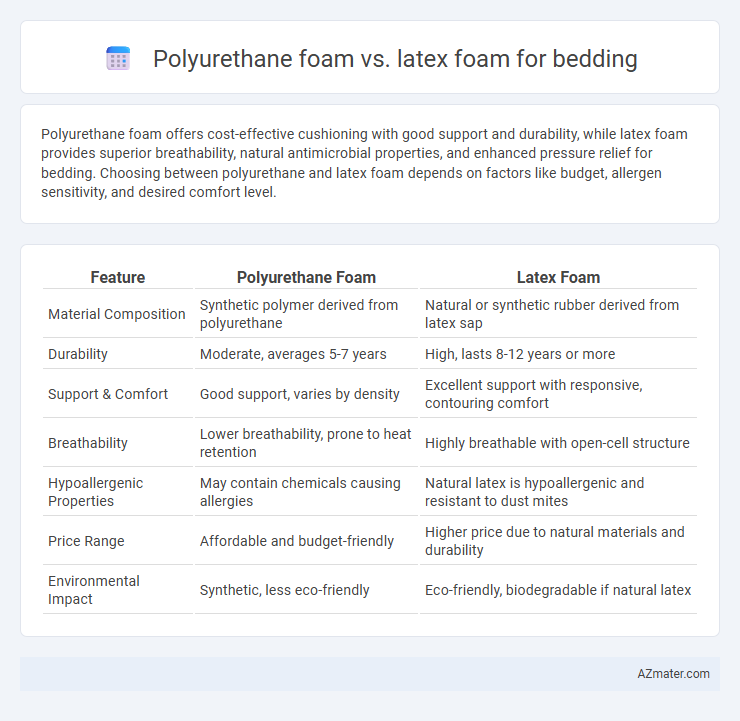Polyurethane foam offers cost-effective cushioning with good support and durability, while latex foam provides superior breathability, natural antimicrobial properties, and enhanced pressure relief for bedding. Choosing between polyurethane and latex foam depends on factors like budget, allergen sensitivity, and desired comfort level.
Table of Comparison
| Feature | Polyurethane Foam | Latex Foam |
|---|---|---|
| Material Composition | Synthetic polymer derived from polyurethane | Natural or synthetic rubber derived from latex sap |
| Durability | Moderate, averages 5-7 years | High, lasts 8-12 years or more |
| Support & Comfort | Good support, varies by density | Excellent support with responsive, contouring comfort |
| Breathability | Lower breathability, prone to heat retention | Highly breathable with open-cell structure |
| Hypoallergenic Properties | May contain chemicals causing allergies | Natural latex is hypoallergenic and resistant to dust mites |
| Price Range | Affordable and budget-friendly | Higher price due to natural materials and durability |
| Environmental Impact | Synthetic, less eco-friendly | Eco-friendly, biodegradable if natural latex |
Introduction to Polyurethane and Latex Foams
Polyurethane foam is a synthetic material widely used in bedding due to its durability, affordability, and versatility in density and firmness options. Latex foam, derived from natural or synthetic rubber, offers superior elasticity, breathability, and hypoallergenic properties, making it a popular choice for eco-conscious consumers. Both foams provide distinct comfort and support characteristics that influence mattress performance and longevity.
Chemical Composition and Manufacturing Processes
Polyurethane foam is synthesized from petrochemical polyols and isocyanates through a chemical reaction creating a versatile open-cell or closed-cell structure, while latex foam is produced from natural or synthetic rubber latex, primarily through Dunlop or Talalay processes involving gelling and vulcanization. Polyurethane foam manufacturing involves mixing chemicals and foaming agents to control density and firmness, whereas latex foam depends on whipping latex into a froth and curing it to achieve elasticity and resilience. Chemical composition differences lead to distinct properties: polyurethane offers customizable firmness and durability, whereas latex provides natural antimicrobial traits and superior breathability.
Comfort and Support: Key Differences
Polyurethane foam offers a balance of moderate firmness and contouring support, making it suitable for those who prefer a firmer sleeping surface with responsive cushioning. Latex foam provides superior elasticity and pressure relief due to its natural bounciness and breathability, enhancing comfort for side sleepers and those with joint pain. The key difference lies in latex's durable, hypoallergenic nature versus polyurethane's affordability and variety in density options, affecting overall comfort and support levels.
Durability and Longevity of Each Foam Type
Polyurethane foam offers moderate durability with a typical lifespan of 5 to 7 years, but it tends to degrade faster under heavy use due to its lower density and susceptibility to heat and moisture damage. Latex foam, especially natural latex, is renowned for superior durability, often lasting 8 to 15 years or more, thanks to its resilient cellular structure that resists sagging and retains shape over time. Choosing latex foam enhances bedding longevity and provides consistent support, making it a preferred option for users prioritizing long-term performance.
Breathability and Temperature Regulation
Polyurethane foam typically has lower breathability compared to latex foam due to its denser cell structure, which can trap heat and reduce airflow. Latex foam features an open-cell structure and natural ventilation properties that promote superior temperature regulation and moisture wicking, making it ideal for hot sleepers. The enhanced airflow in latex foam supports a cooler sleeping environment, reducing night sweats and improving overall sleep quality.
Allergy Considerations and Hypoallergenic Properties
Latex foam is naturally hypoallergenic and resistant to dust mites, mold, and mildew, making it an excellent choice for allergy sufferers. Polyurethane foam, especially low-quality types, can off-gas volatile organic compounds (VOCs) and may trap allergens over time, potentially aggravating respiratory issues. Choosing natural or organic latex foam prioritizes a healthier sleeping environment with fewer airborne irritants compared to conventional polyurethane foam mattresses.
Environmental Impact and Sustainability
Polyurethane foam, a petroleum-based product, has significant environmental drawbacks due to its non-renewable resource base and challenges in biodegradability, often releasing volatile organic compounds (VOCs) during production and disposal. Latex foam, particularly natural latex derived from rubber trees, offers enhanced sustainability with renewable sourcing, biodegradable properties, and lower chemical emissions, contributing to reduced environmental impact over its lifecycle. Consumers aiming for eco-friendly bedding prefer natural latex foam for its durability, lower carbon footprint, and support of sustainable agricultural practices.
Cost Comparison: Polyurethane vs Latex Foam
Polyurethane foam is generally more affordable than latex foam, making it a popular choice for budget-conscious buyers seeking comfortable bedding options. Latex foam, derived from natural or synthetic latex, commands a higher price due to its durability, hypoallergenic properties, and eco-friendliness. The initial investment in latex foam tends to be higher, but its long lifespan and resilience often result in better value compared to the more cost-effective yet less durable polyurethane foam.
Applications in Mattresses and Bedding Products
Polyurethane foam offers excellent support and durability, making it ideal for mattresses requiring firm, long-lasting comfort with good motion isolation. Latex foam provides superior breathability and natural resilience, enhancing pressure relief and temperature regulation in premium bedding products. Both materials are widely used in mattress layers and toppers, with polyurethane favored for budget-friendly options and latex preferred for eco-friendly, hypoallergenic bedding.
Choosing the Right Foam for Your Sleep Needs
Polyurethane foam offers excellent support and durability, making it suitable for sleepers seeking firm and long-lasting bedding. Latex foam provides natural breathability and pressure relief, ideal for those prioritizing hypoallergenic properties and a responsive, contouring feel. Selecting the right foam depends on preferences for firmness, temperature regulation, and sensitivity to allergens to enhance overall sleep quality.

Infographic: Polyurethane foam vs Latex foam for Bedding
 azmater.com
azmater.com